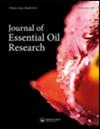Evaluation of antimicrobial and antioxidant activity of Carum copticum L. essential oil encapsulated in electrospun cellulose acetate nanofibers
IF 2.1
3区 农林科学
Q3 CHEMISTRY, APPLIED
引用次数: 0
Abstract
ABSTRACTThe objective of this research was to nanoencapsulate ajwain (Carum copticum L.) essential oil (EO) in cellulose acetate (CA) using the electrospinning technique and evaluate its antioxidant and antimicrobial activity. The main components of ajwain EO were thymol, p-cymene, and γ- terpinene. A zeta potential of −40.11, −37.85, −35.50, and −31.74 mV was found for nanofibers of pure CA, CA/EO 1%, 2.5%, and 5%, respectively. According to SEM images, CA electrospun nanofiber loaded with different concentrations of ajwain EO had nano-scale size and uniform morphology. The antibacterial activity enhanced with higher concentrations of EO, and it was higher for nanoencapsulated EO at the same concentration. The fibers loaded with EO were effective against the microbial strains according to the following decreasing order: E. coli > S. enteritidis > S. dysenteriae > L. monocytogenes > S. aureus. Results of the antioxidant assays showed that the ABTS and DPPH scavenging capacity and reduction potential of Fe3+ of free and nanoencapsulated EO were as follows: CA/EO 5% = CA/EO 2.5% > EO 5% > CA/EO 1% > EO 2.5% > EO 1%. Antioxidant and antibacterial activities of all EO-loaded CA nanofibers were higher than free EO.KEYWORDS: Ajwaincellulose acetateelectrospinningessential oilnanoencapsulation Disclosure statementThe authors declare that they do not have any conflict of interest.Additional informationFundingThis work was supported by a research grant from the Amol University of Special Modern Technologies, Amol, Iran.静电纺醋酸纤维素纳米纤维包封的黄连精油抑菌和抗氧化活性评价
摘要本研究采用静电纺丝技术将黄豆精油(Carum copticum L.)纳米包封在醋酸纤维素(CA)中,并评价其抗氧化和抗菌活性。主要成分为百里酚、对伞花烃和γ-萜烯。纯CA、CA/EO浓度为1%、2.5%和5%的纳米纤维的zeta电位分别为- 40.11、- 37.85、- 35.50和- 31.74 mV。SEM图像显示,负载不同浓度的ajwaain EO的CA静电纺纳米纤维具有纳米级的尺寸和均匀的形貌。EO的抑菌活性随着EO浓度的增加而增强,相同浓度的EO纳米胶囊的抑菌活性更高。负载EO纤维的抑菌效果依次为大肠杆菌>肠炎链球菌>痢疾链球菌>单核增生乳杆菌>金黄色葡萄球菌。结果表明,游离EO和纳米封装EO对ABTS和DPPH的清除能力和对Fe3+的还原电位依次为:CA/EO 5% = CA/EO 2.5% > EO 5% > CA/EO 1% > EO 2.5% > EO 1%。负载EO的CA纳米纤维的抗氧化和抗菌活性均高于游离EO。关键词:ajwain醋酸纤维素电纺丝精油纳米胶囊披露声明作者声明他们没有任何利益冲突。本研究得到了伊朗Amol特殊现代技术大学的研究资助。
本文章由计算机程序翻译,如有差异,请以英文原文为准。
求助全文
约1分钟内获得全文
求助全文
来源期刊

Journal of Essential Oil Research
工程技术-食品科技
CiteScore
6.00
自引率
3.30%
发文量
52
审稿时长
18-36 weeks
期刊介绍:
Journal of Essential Oil Research ( JEOR) is the major forum for the publication of essential oil research and analysis. Each issue includes studies performed on the chemical composition of some of the 20,000 aromatic plants known in the plant kingdom. JEOR is devoted entirely to all phases of research from every corner of the world by the experts in their field. JEOR''s main areas of focus include:
-Analytical chemistry-
Biological activity-
Biotechnology-
Chemical composition-
Chemical synthesis-
Chemosystematics-
Microbiological activity-
Plant biochemistry/biosynthesis-
Toxicology.
Published six times per year, JEOR provides articles on the aromatic principles of a plant or its isolates and are directed toward furthering our readers'' knowledge of the aromatic plant and animal kingdoms.
 求助内容:
求助内容: 应助结果提醒方式:
应助结果提醒方式:


